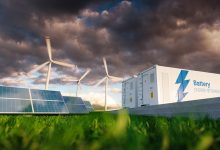Swedish power company Vattenfall has announced it will build a new hybrid energy park in Netherlands consisting of wind, solar, and battery storage, and with a total capacity of 60MW.
As renewable energy and battery storage technologies grow in their development cycles and decrease in price, developers have begun to explore ways in which these technologies can work together.
The Vattenfall project will be built at the Haringvliet inlet in the Netherlands and will include a 22MW wind park with 6 turbines, a 38MW solar farm boasting 124,000 solar panels, and a battery storage component with 12MWh of storage.
Australia’s Windlab has built the world’s first wind-solar-battery hybrid project at the Kennedy Energy Hub in north Queensland, although that project is configured differently with 43MW of wind, 15MW of solar and a 4MW/4MWh battery.
The €61 million ($A101 million) Vattenfall project is expected to be in operation by September 2020 and, upon completion, will generate enough electricity for the equivalent of 40,000 average Dutch homes.
“Vattenfall wants to enable fossil-free living within one generation and hybrid power plants are an important building block for us in the direction of 100% fossil-free power generation,” said Gunnar Groebler, Senior Vice President and Head of Business Area Wind, Vattenfall.
“The complementary wind and solar generation profiles reduce the load on the grid compared to a single generation technology.
“Hybrid systems provide less pronounced peaks and we see fewer total times without production. This leads to a more efficient use of the network infrastructure. In addition, the costs for grid connection are significantly reduced compared to stand-alone systems. This will reduce the cost of renewable electricity and ultimately benefit customers.”
Construction will begin with the installation of six wind turbines in the north of Goeree-Overflakkee island between Middelharnis and Stad aan ‘t Haringvliet, before work on the solar farm can then commence. Batteries, to be supplied by BMW, will be installed in 12 shipping containers on the solar farm.
Vattenfall’s announcement comes less than a month after North American company NextEra Energy Resources announced a 250 MW onshore wind farm, a 250MW solar energy project, and a 200MW, 4-hour battery energy storage project.
This beat its February-announcement of a rival project boasting 300 MW of wind, 50 MW of solar, and 30 MW/120 MWh of energy storage.
“Pairing renewable energy with battery storage presents a tremendous advantage for Western Farmers and its customers,” said John Ketchum, president and chief executive officer of NextEra Energy Resources.
“With this combined facility, we can optimize and maximize the amount of low-cost, emissions-free electricity we provide, while helping Western Farmers diversify its power generation portfolio, reduce its dependence on fossil fuels and set a great example for others to follow.”
Australia has its own mega projects that will combine wind, solar and storage, most notably the 4GW Walcha Energy Project Project in New South Wales, which recently announced the involvement of Vestas Wind Systems A/S who will step in as a majority stakeholder for the Winterbourne wind farm, the first stage of the larger Walcha Energy Project Project.
The Vestas announcement came at the same time as Walcha Energy announced that it has submitted its scoping study for a 700MW solar farm, a 100MW/150MWh battery and its plans for a renewable energy hub at Uralla – in the New England area of NSW – to the state’s department of planning and environment.








